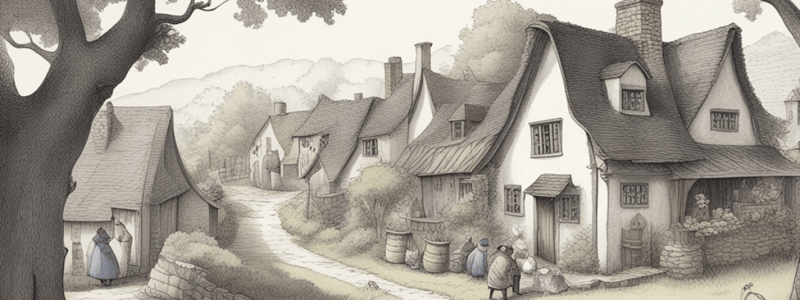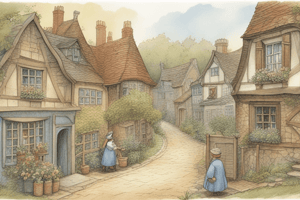Podcast
Questions and Answers
Ремесленники производили различные товары, включая керамику, текстиль, металлоизделия, изделия из стекла и миниатюрные рукописи.
Ремесленники производили различные товары, включая керамику, текстиль, металлоизделия, изделия из стекла и миниатюрные рукописи.
True (A)
Гильдии отвечали за поддержание стандартов качества продукции и работоспособности.
Гильдии отвечали за поддержание стандартов качества продукции и работоспособности.
True (A)
Согласно тексту, города сражались против феодальных лордов, чтобы получить контроль над собственными территориями и подданными.
Согласно тексту, города сражались против феодальных лордов, чтобы получить контроль над собственными территориями и подданными.
True (A)
Феодалы не предпринимали попыток подчинить города через контроль над торговлей и налогами.
Феодалы не предпринимали попыток подчинить города через контроль над торговлей и налогами.
Рост торговли и развитие гильдий спровоцировали период экономического роста и инноваций в средневековых городах.
Рост торговли и развитие гильдий спровоцировали период экономического роста и инноваций в средневековых городах.
Как отделялось ремесло от сельского хозяйства?
Как отделялось ремесло от сельского хозяйства?
______ - это центры ремесла и торговли. Возникновение и
рост городов - закономерное следствие отделения ремесла от сельского хозяйства.
______ - это центры ремесла и торговли. Возникновение и рост городов - закономерное следствие отделения ремесла от сельского хозяйства.
Соедините понятие и определение
Соедините понятие и определение
Study Notes
Medieval Cities: Urban Life and Transformations
During the Middle Ages, cities emerged as hubs of commerce, culture, and power, transforming the landscape of Europe. This article will delve into the key aspects of medieval urbanization, focusing on the role of trade, guilds, artisanship, and the struggle of cities against feudal lords.
Urbanization: A Growing Phenomenon
Medieval urbanization began in the 11th century, following a period of gradual population growth and renewed trade connections with the Islamic World and Byzantium. By the 14th century, cities boasted a significant portion of the Western European population, serving as the backbone of trade and innovation.
Trade and Commerce
Medieval cities thrived as centers of trade, largely due to their strategic locations and the development of trade routes. The Hanseatic League, a powerful trade confederation, played a significant role in the economic growth of several prominent cities, such as Lübeck, Hamburg, and Bremen. Cities also benefited from the rise of fairs, where merchants could gather to trade goods such as cloth, spices, wine, and luxury items.
Guilds and Artisans
Guilds, professional associations of artisans and merchants, emerged as a means of regulating trade, maintaining quality standards, and protecting the interests of their members. Guilds were also important in perpetuating specific craft traditions and skills. The most prominent guilds included the wool guilds, metalworkers, and masons. The guilds were also responsible for maintaining the standards of workmanship and the quality of the products.
Ремесло (Artisanship)
Artisans, the skilled craftsmen who produced various goods, played a crucial role in the development of medieval cities. The rise of trade and the growth of cities led to an increased demand for goods and services, providing artisans with new opportunities for success. Medieval artisans were responsible for creating a wide range of goods, including pottery, textiles, metalwork, glassware, and illuminated manuscripts.
Борьба городов с сеньорами (The Struggle of Cities Against Feudal Lords)
Medieval cities often found themselves embroiled in conflicts with feudal lords, who sought to exert control over their territories and subjects. Cities, however, fought back by asserting their rights and privileges, and they often succeeded in gaining significant degrees of autonomy and independence. In some cases, cities were able to secure the right to elect their own officials, control their own taxes, and maintain their own militias.
The struggle between cities and feudal lords was not always peaceful, and conflicts sometimes erupted into open warfare. In some cases, feudal lords attempted to subjugate cities by exerting control over trade and imposing heavy taxes. Cities, in turn, sought to resist such attempts and to assert their rights and privileges.
In conclusion, medieval cities were complex and dynamic centers of trade, culture, and power. The emergence of cities, along with the development of trade, guilds, and artisanship, sparked a period of economic growth and innovation. The struggle of cities against feudal lords was a defining feature of the medieval age, as cities sought to assert their rights and privileges and to secure their autonomy and independence. As we trace the history of medieval cities, we witness the emergence of the modern world, with its cities and their role as hubs of trade, culture, and innovation.
Studying That Suits You
Use AI to generate personalized quizzes and flashcards to suit your learning preferences.
Description
Explore the key aspects of medieval urbanization, including the role of trade, guilds, artisanship, and the struggles of cities against feudal lords during the Middle Ages in Europe.




